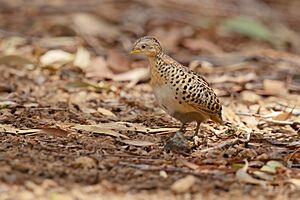Red-backed buttonquail facts for kids
Quick facts for kids Red-backed buttonquail |
|
|---|---|
 |
|
| Conservation status | |
| Scientific classification | |
| Genus: |
Turnix
|
| Species: |
maculosus
|
| Synonyms | |
|
|
The red-backed buttonquail (Turnix maculosus) is a small bird that looks a bit like a quail. It belongs to the family Turnicidae. You can find these birds in many places, including Australia, Indonesia, Papua New Guinea, the Philippines, and the Solomon Islands. People sometimes call it by other names like the black-backed buttonquail or orange-breasted buttonquail. There are fourteen different types, or subspecies, of this bird!
Contents
What Does It Look Like?
The red-backed buttonquail is a small, plump bird. It has rounded wings and a short tail. These birds are usually between 12 and 16 centimeters (about 5 to 6 inches) long.
Female buttonquails are bigger than males. Females weigh about 32 to 51 grams (1.1 to 1.8 ounces). Males are lighter, weighing 23 to 39 grams (0.8 to 1.4 ounces).
One type, T. m. melanotus, lives in northern Australia. It has a pale yellow beak and yellowish eyes. Its legs and feet are also yellowish. The top of its head is dark with gray patterns. Its neck and throat are brownish-buff. It also has a reddish-brown collar.
The upper part of its body is gray with thin reddish-brown and black stripes. The feathers under its wings are light gray. Its lower throat is whitish. This color changes to buff on its chest and belly. The sides of its body have clear spots and patterns.
Both male and female buttonquails look similar. However, the female has brighter colors. Her beak is a brighter yellow. Her chestnut collar is also more noticeable. Young birds are much darker in color. Other types of buttonquails have slightly different colors.
Where Does It Live?
This buttonquail lives in southeastern Asia and Oceania. Its home range includes Indonesia, Papua New Guinea, the Philippines, the Solomon Islands, and East Timor. It also lives in Australia. In Australia, it can be found along the coast. This includes areas from northeastern Western Australia down to northeastern New South Wales.
It mostly lives in grassy areas with tall clumps of grass. It also likes woods and farmed land. These birds usually stay in low-lying areas. However, one type, T. m. giluwensis, can be found over 2,000 meters (about 6,500 feet) high. This is in east-central New Guinea.
In Australia, they are often found near water. They only live in places that get at least 400 millimeters (about 16 inches) of rain in summer. They stay in areas that get at least 800 millimeters (about 31 inches) of rain each year.
Daily Life and Habits
The red-backed buttonquail is mostly active when the sun goes down and at night. It is a bird that lives on the ground. It moves around alone or in pairs. Sometimes, you might see small groups of up to five birds.
If something bothers it, the bird might "freeze" (stay very still) or run away. It rarely flies. When it does fly, it usually does not go very far. However, some groups of these birds might travel to different places. They probably travel at night. We do not know much about how these birds move around.
The buttonquail eats seeds from grasses and other plants. It also eats green plant parts and insects. It probably eats more insects than other birds in its group.
Reproduction and Family Life
Red-backed buttonquails usually lay eggs between October and June. They build their nests at the bottom of a clump of grass. These nests are often in tall grasses in wet areas.
The nest is a small hollow in the ground. It is lined with grass, leaves, and small bits of animal waste. Often, the birds weave nearby grasses together to make a roof over the nest.
After the female lays two to four whitish eggs with dark speckles, the male takes over. He sits on the eggs to keep them warm. He is also the only one who takes care of the young birds. The female then goes to find another male. She repeats the breeding process with him.
Is It Endangered?
The red-backed buttonquail (T. maculosus) lives in a very large area. It is a common bird, except in southeastern Australia where it is not seen as often.
Experts believe the total number of these birds is going down. This is because their homes are being damaged. However, the population is not shrinking fast enough to put the bird at great risk. Because of this, the International Union for Conservation of Nature says its conservation status is "least concern". This means it is not currently in danger of disappearing.


